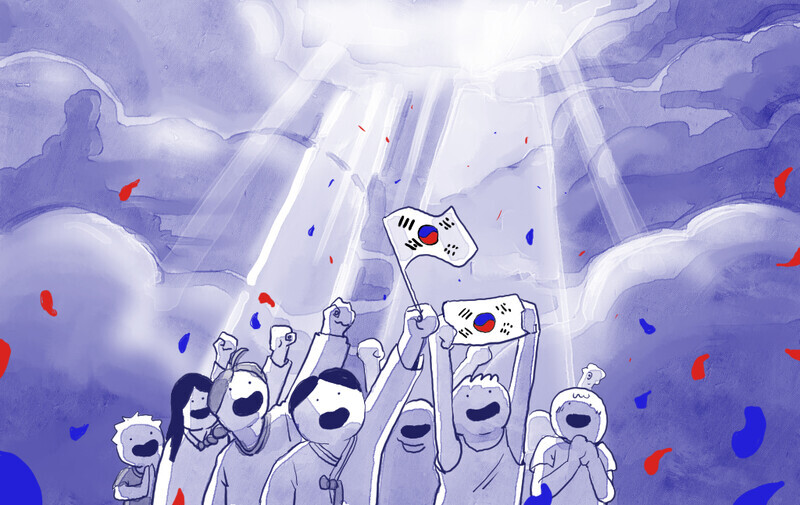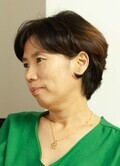hankyoreh
Links to other country sites 다른 나라 사이트 링크
[Guest essay] Commemorating Korean liberation in Hawaii


This year, I spent Korean Liberation Day in Hawaii.
Had I been in Seoul, I would have been reminded of the occasion by Korean flags fluttering in apartments across the way or special documentaries being broadcast on television. But here in Hawaii, the experience was different.
I took this opportunity to visit the Pearl Harbor National Memorial and Honouliuli, the site of an internment camp for people of Japanese descent during World War II.
That’s right — Pearl Harbor is in Hawaii. So is the USS Missouri.
Japan’s unconditional surrender in World War II on Aug. 15, 1945, took place aboard the battleship, which was docked in Tokyo Bay. After taking part in the Korean War, the USS Missouri returned to Pearl Harbor, where it currently serves as a floating museum.
It feels a little refreshing yet unfamiliar to spend Liberation Day in Hawaii, a place that offers a peak at the beginning and end of the Pacific War, where tales of war and peace are scattered between wind and waves, surfing and sunsets.
Japan’s surprise attack on Pearl Harbor marked a turning point in World War II in several respects. The attack spurred the US, which had previously stayed out of the conflict in Europe, to leap into the war, extending the front into the Pacific Ocean. The attack was the prelude to the Pacific War, the second theater of World War II, which turned the entire world into a battlefield.
The strategic goal of Japan’s bombing of Pearl Harbor was to bring the US to the negotiating table. In 1941, the US had placed an embargo on exports of oil to Japan and frozen Japanese assets in the country. Those steps were intended as warnings to Japan, which was waging war not only in China but also in Southeast Asia.
The damage was significant for Japan, which imported 80% of its petroleum from the US. Warships and fighter planes were useless without petroleum. Faced with a blockade of supplies needed for war, Japan made a plan to obtain necessary resources from Southeast Asia, as it had occupied Indochina — previously a French colony — while France was occupied by Germany in 1940.
By additionally occupying the Dutch East Indies (now Indonesia), where natural resources like petroleum and rubber were plentiful, Japan would secure sufficient war supplies, and this plan wouldn’t pose any problems, as the military of Germany — Japan’s ally — was stationed in the Netherlands. Once the US Navy was neutralized in the Pacific Ocean, the US would attempt negotiations, and the Japanese military reasoned that a preemptive surprise attack was necessary to gain the upper hand at the negotiating table. The Japanese Cabinet, which would have made political decisions, had long been a nominal entity.
“Mother told me to pick some papayas and prepare breakfast. When I got on top of the garage roof and attempted to pick the ripe yellow fruit, the plane suddenly started to dive toward me. Mother was on her way back from collecting eggs from the chicken coop. [. . .] I saw smoke surging from the Wheeler Air Force Base and enveloping the eucalyptus forest. [The plane] fired a machine gun from King’s Highway in Kamehameha, shattering the glass window of the house across from the path I stood.” (“First Generation Korean Immigrants in Hawaii,” 2003, Dulnyouk Publishing)
This vivid testimony was given by none other than a Korean individual. At the time of the attack on Pearl Harbor, Hawaii was home to a diverse population including native Hawaiians, white people, Chinese, Japanese, Koreans, Filipinos, Puerto Ricans and Portuguese. Most Asian inhabitants of Hawaii were immigrant laborers working in sugarcane plantations as well as their descendants. The attack on Pearl Harbor created a significant fissure in Hawaii’s multiethnic society. After Hawaii transformed into a battlefield with over 2,000 casualties, sunken warships, burning planes, and a nonfunctional airport, martial law was declared on the island, and a military government was established. Curfews, blackouts and press censorship soon followed.
The US White House declared Executive Order 9066, designating Japanese people as enemies. Japanese individuals who had been living in the US since 1885 through labor immigration were labeled “enemies” overnight, even if they had been born in the US and had American citizenship. This decision was influenced by the Niihau incident.
When a Japanese resident helped a Japanese pilot who had crash-landed on Niihau Island at the time of the attack on Pearl Harbor, prompting casualties in the process, public opinion in the US boiled over. The terror of having been invaded, added with hate against Asians, resulted in the popularization of the sentiment that Japanese Americans should be interned, which led to the signing of Executive Order 9066. This became the legal basis for the internment or deportation of residents of the US from Japan and other hostile countries, leading to the forced internment of over 100,000 Japanese Americans who lived in Hawaii or the US mainland. The problem was Koreans.
Military judicial officers and immigration authorities in Hawaii regarded first-generation Korean Americans as Japanese subjects, deciding to categorize them as citizens of an enemy country. Korean Americans immediately responded with fierce opposition. They formed a joint commission of Koreans in the US, attempting negotiations with martial law authorities. More than anything else, they couldn’t bear the fact that they were being categorized as Japanese.
In fact, Korean immigrants in Hawaii were some of the most avid participants of the Korean independence movement. They gladly donated money they earned by working more than 10 hours a day on sugarcane plantations to the Korean provisional government’s independence fund. They even contributed to An Jung-geun’s legal fees. They also formed a military education group called the Great Joseon National Corps, and carried out military training.
After persistent negotiations and persuasion, martial law authorities of Hawaii did not apply legislation regarding Hawaiian residents from enemy countries to Korean Americans so strictly. It did not intern Koreans in Hawaii either. It became possible for Korean immigrants to work in fields that Japanese immigrants were now excluded from. Still, first-generation Korean Americans who were not able to gain American citizenship were officially classified as residents from hostile countries and subsequently subject to restrictions.
In comparison, second-generation Korean Americans born in Hawaii were US citizens. If first-generation Korean Americans considered the Pacific War an opportunity for Korean independence, second-generation Korean Americans perceived the war as one between the US and Japan. For them, the US was their home country, while Korea was that of their mother and father. The reason many young Koreans joined the US military was in order to protect the US, the foundation of their lives.
Things were similar for second-generation Japanese Americans. Despite having been born and raised in the US and thinking of themselves as American, they were labeled citizens of a hostile country overnight, suddenly subject to discrimination, violence, and internment. Young Japanese Americans sought ways to prove that their home country was the US, and one of them was joining the military. The 442nd Infantry Regiment was made up of Japanese Americans from Hawaii and the US mainland. Also known as the Nisei regiment, as it was composed of second-generation immigrants only, the regiment received the most medals compared to how long it was active within the US Army. In other words, the regiment suffered countless deaths and injuries.
The site of the Japanese internment camp in Honouliuli was closed when I arrived at it. Although it was named a national monument during the Barack Obama administration, I was not able to visit the location. On my way back to where I was staying, I thought about what makes a nation. I also asked who it is that gets to categorize me. Which side loses out when the state and individual clash? Learning more about the layers and layers of stories contained in the history of Korean liberation is a strange experience every time. This ray of light that reached me after passing through heavy darkness, fog, rainstorms and clouds. Liberation — how fresh it feels.
Please direct questions or comments to [english@hani.co.kr]

Editorial・opinion
![[Column] Park Geun-hye déjà vu in Yoon Suk-yeol [Column] Park Geun-hye déjà vu in Yoon Suk-yeol](https://flexible.img.hani.co.kr/flexible/normal/500/300/imgdb/original/2024/0424/651713945113788.jpg) [Column] Park Geun-hye déjà vu in Yoon Suk-yeol
[Column] Park Geun-hye déjà vu in Yoon Suk-yeol![[Editorial] New weight of N. Korea’s nuclear threats makes dialogue all the more urgent [Editorial] New weight of N. Korea’s nuclear threats makes dialogue all the more urgent](https://flexible.img.hani.co.kr/flexible/normal/500/300/imgdb/original/2024/0424/7317139454662664.jpg) [Editorial] New weight of N. Korea’s nuclear threats makes dialogue all the more urgent
[Editorial] New weight of N. Korea’s nuclear threats makes dialogue all the more urgent- [Guest essay] The real reason Korea’s new right wants to dub Rhee a founding father
- [Column] ‘Choson’: Is it time we start referring to N. Korea in its own terms?
- [Editorial] Japan’s rewriting of history with Korea has gone too far
- [Column] The president’s questionable capacity for dialogue
- [Column] Are chaebol firms just pizza pies for families to divvy up as they please?
- [Column] Has Korea, too, crossed the Rubicon on China?
- [Correspondent’s column] In Japan’s alliance with US, echoes of its past alliances with UK
- [Editorial] Does Yoon think the Korean public is wrong?
Most viewed articles
- 1[Column] Park Geun-hye déjà vu in Yoon Suk-yeol
- 2Will NewJeans end up collateral damage in internal feud at K-pop juggernaut Hybe?
- 3Thursday to mark start of resignations by senior doctors amid standoff with government
- 4Why Korea shouldn’t welcome Japan’s newly beefed up defense cooperation with US
- 5‘We must say no’: Seoul defense chief on Korean, USFK involvement in hypothetical Taiwan crisis
- 6[Guest essay] The real reason Korea’s new right wants to dub Rhee a founding father
- 7N. Korean hackers breached 10 defense contractors in South for months, police say
- 8[Column] ‘Choson’: Is it time we start referring to N. Korea in its own terms?
- 9[Editorial] New weight of N. Korea’s nuclear threats makes dialogue all the more urgent
- 10Kim Jong-un expressed ‘satisfaction’ with nuclear counterstrike drill directed at South